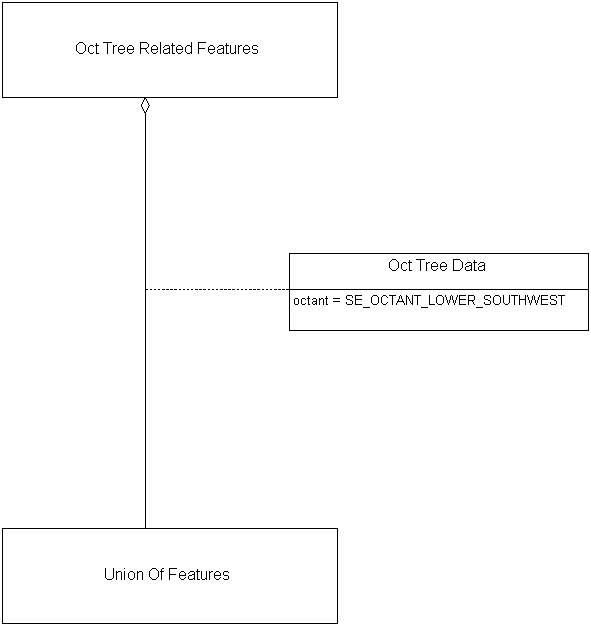Consider an Octtree that is represented in a transmittal by an <Oct Tree Related Features> instance. The lower left octant of the Octtree is a <Union Of Features> aggregated by the <Oct Tree Related Features> as follows:

|
The SEDRIS Data Representation Model
APPENDIX A - Classes Oct Tree Related Features |
|---|
An instance of this DRM class is an aggregation of <Feature Hierarchy> objects in which each component <Feature Hierarchy> represents a branch of an Oct Tree. The octant represented by a branch is specified by the Oct Tree Data associated with that branch. The bounding region that the <Feature Hierarchy> components occupy is defined by the <Spatial Domain> of the <Oct Tree Related Features>.
Consider an Octtree that is represented in a transmittal by an <Oct Tree Related Features> instance. The lower left octant of the Octtree is a <Union Of Features> aggregated by the <Oct Tree Related Features> as follows:

An <Oct Tree Related Features> is used when an object in the hierarchy contains spatial components that occupy a certain octant. These octants might not contain <Primitive Features>, which is why this class can have less than 8 components.
<Oct Tree Related Features> automatically has a <Spatial Domain> component, because it is a <Feature Hierarchy>. However, unlike other classes descended from <Feature Hierarchy>, <Oct Tree Related Features> has a constraint stating that the <Spatial Domain> component is mandatory.
| SE_Boolean | unique_descendants; | (notes) |
|---|---|---|
| SE_Boolean | strict_organizing_principle; | (notes) |
An association between two <Feature> instances indicates that they are alternate representations of the same environmental object.
An association between a <Geometry Hierarchy> instance and a <Feature> instance indicates that the <Geometry Hierarchy> and the <Feature> are alternate representations of the same environmental object.
An association between a <Property Grid> instance and a <Feature> instance indicates that the <Feature> and the <Property Grid> (or some specific cell data within that <Property Grid>) are alternate representations of the same environmental object. Each associated <Property Grid> will indicate which is the case.
This relationship exists to support "attributes for derived objects." That is, these components are used only to specify texture mapping information for geometry that is to be derived from the <Aggregate Feature> by the consumer. These <Image Mapping Function> instances shall use <Image Anchor> components to specify the mapping.
This is needed for cases in which an <Aggregate Feature> is significant only for a particular domain, such as radar.
If this value is SE_TRUE, each 'descendant' of this aggregation - that is, each <Feature> instance that exists in the component tree rooted at the given <Aggregate Feature> - shall be unique, in the sense that it shall appear in only one 'branch' of this aggregation. If unique_descendants is SE_FALSE, at least one <Feature> instance appears in more than one 'branch' of the aggregation.
If this value is SE_TRUE, each 'branch' of this aggregation strictly complies with the organizing principle for its particular subclass. If this value is SE_FALSE, at least one 'branch' does not strictly comply with the given organizing principle. See the organizing principle constraint for each specific subclass for details.
|